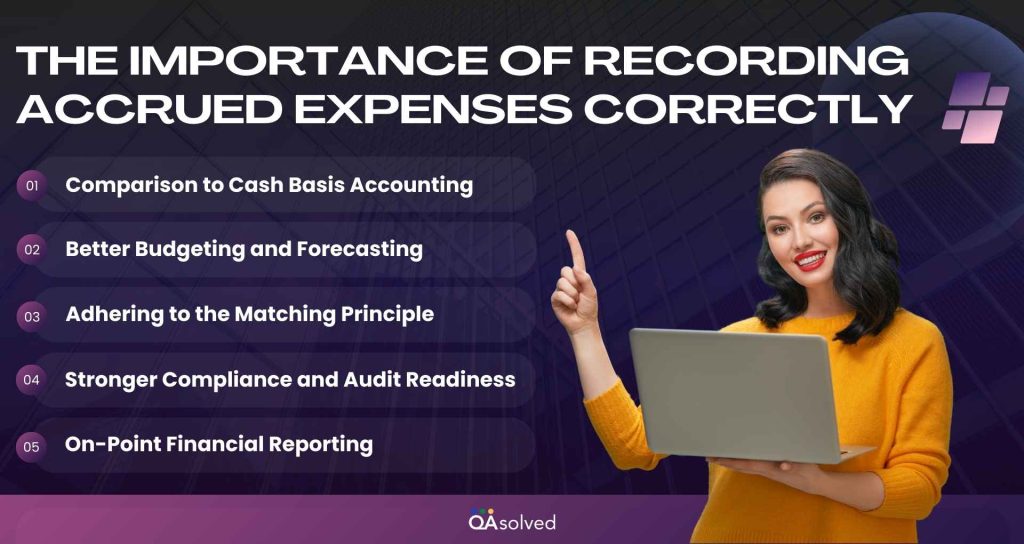Accrued expenses in QuickBooks play a crucial role in helping businesses keep their financial records accurate, especially when costs are incurred before they are actually paid. Whether you’re managing vendor bills, payroll liabilities, or monthly utilities, understanding how to record these expenses properly ensures that your books reflect a true picture of your company’s financial health. Many small business owners overlook accrual entries because the expense hasn’t yet been paid, but this can lead to misstated profits and confusing end-of-year reporting.
In QuickBooks, recording accrued expenses is a simple process once you understand the workflow. By making proper journal entries and adjusting your accounts at the right time, you can match your expenses to the period in which they occur, not when the cash leaves your account. In this blog, we’ll walk you through what accrued expenses are, why they matter, and the exact steps to record them correctly in QuickBooks.
Let’s jump right into it.
What Are Accrued Expenses? Definition, Examples, and Importance
Accrued expenses are costs that a business has incurred but hasn’t yet paid. These can include utilities, wages, interest, or vendor services that are already delivered but not yet billed or settled. Recording accrued expenses in QuickBooks ensures your books reflect the true financial position of your business, even when cash hasn’t moved yet. This approach helps maintain accuracy, supports better decision-making, and keeps your books aligned with standard accounting principles.
7 Examples of Accrued Expenses
Accrued expenses appear in many everyday business situations where services or obligations are received before payment is made. Some common examples include:

1. Utilities
Think of your monthly electricity, water, or internet usage. You rely on these services every day, but the bill usually arrives after the month ends. Since the service has already been consumed, the cost is recorded as an accrued expense until the invoice is received.
2. Wages and Salaries
Employees often work through the final days of a month, but their payroll doesn’t run until the following pay cycle. These unpaid yet earned wages need to be accrued, so your financial statements reflect the actual labor cost for that period.
3. Interest on Loans
Loan interest accumulates a little every day, even though you may only pay it monthly or quarterly. Because the interest has already accrued, it must be recorded as an expense before the payment is made.
4. Professional or Contractor Services
Consultants, freelancers, and service providers may finish their work before sending an invoice. Since the service is already delivered, the cost should be accrued to avoid understating your expenses for that month.
5. Taxes
Certain taxes, such as payroll tax or property tax, build up over time but are only paid periodically. These unpaid amounts represent obligations that should be recognized as accrued expenses.
6. Rent
If your rent period ends before the payment is made, the amount becomes an accrued expense. This ensures your books reflect the actual cost of occupying the space during that month.
7. Insurance Adjustments
Even if you pay your insurance premium annually, you use the coverage month by month. Each month’s share of the insurance cost is considered an accrued expense to keep your books consistent and accurate.
Accrued expenses cover everyday costs your business has already used but hasn’t paid for yet. Recording them ensures your financials stay accurate and reflects real business activity. Now that you’re aware of the different aspects that fall under accrued expenses, let’s highlight the significance of recording them.
The Importance of Recording Accrued Expenses Correctly
Properly recording accrued expenses helps businesses capture the true picture of their financial obligations. Here are the five key reasons why accruing expenses is important:

1. Comparison to Cash Basis Accounting
Unlike cash basis accounting, which only recognizes expenses when money changes hands, accruing expenses ensures that your financials reflect economic activity rather than cash flow timing. This leads to clearer performance insights.
2. Better Budgeting and Forecasting
Accrued expenses allow businesses to anticipate upcoming payments and plan cash flow more effectively. This helps avoid surprises and supports long-term financial planning.
3. Adhering to the Matching Principle
Accrued expenses help you follow the accounting matching principle, which states that expenses should be recorded in the same period as the revenues they support. This gives a more accurate picture of profitability for that specific period.
4. Stronger Compliance and Audit Readiness
Keeping track of unpaid but incurred expenses creates transparent records, reducing discrepancies during audits and ensuring compliance with accounting standards.
5. On-Point Financial Reporting
When expenses are recorded as soon as they occur, your financial statements become more reliable. You avoid overstating profits or understating liabilities, making your reports more trustworthy for audits, budgeting, and decision-making.
These five points highlight why accruing expenses is essential for maintaining accurate, compliant, and forward-looking financial records. And now that you understand the significance of recording accrued expenses, let’s move on to how you can enter and record accrued expenses in QuickBooks in a clear, step-by-step way.
How to Enter and Record Accrued Expenses in QuickBooks?
Managing accrued expenses in QuickBooks helps ensure your books reflect costs at the right time, even before payments are made. You can record your month-end accruals in QuickBooks by following a few simple actions:
- Open QuickBooks and go to the Lists menu.
- Click Chart of Accounts to view your list of accounts.
- Select the account where you want to add the month-end accrual.
- Choose Edit Account from the available options.
- In the Account Type field, select Accrual.
- Enter the appropriate accrual amount in the Balance field.
- Click OK to save and apply the changes.
So, these are the seven steps that can help you record accrued expenses in QuickBooks. But what if you want to reverse these month-end accruals? Well, let’s take a look at that.
How to Undo Month-End Accruals in QuickBooks?
Reversing month-end accruals in QuickBooks helps reset temporary entries once the actual bills or payments are recorded. This ensures your accounts stay accurate and prevents duplicate expenses. QuickBooks lets you clear these accruals easily by updating or removing the original journal entry. Here’s a straightforward way to do it.
- Click the New button located in the upper-left corner of your screen.
- Under the Other section, choose Journal Entry.
- Look for the accrual journal entry from the previous period. You can search using the journal number, date, or description.
- Update the journal entry date to the first day of the current period. For example, if the original accrual was recorded on January 31, change the date to February 1.
- At the bottom of the Journal Entry window, select Reverse. QuickBooks will automatically switch the debits and credits from the original entry.
- When you’re done, click Save and Close to complete the reversal.
These steps will help you successfully reverse month-end accruals in QuickBooks. Now, let’s take a look at how accrued expenses differ from accounts payable and prepaid expenses.
How Accrued Expenses Are Different from Prepaid Expenses and Accounts Payable?
Accrued expenses, accounts payable, and prepaid expenses all relate to the timing of when costs are recorded in your books. While they may seem similar, each one reflects a different stage of when a business receives, owes, or pays for a service. Understanding the differences helps ensure your financial statements stay accurate and organized. Here’s a detailed description:
Accrued Expenses vs Prepaid Expenses
| Basis | Accrued Expenses | Prepaid Expenses |
| Accounting Treatment | Accrued expenses are recorded as a liability or an expense. | Whereas prepaid expenses are recorded as an asset, they are later expensed over time as benefit is used. |
| Timing | Payment is made and recorded after use. | Payment is made and recorded before use. |
| Balance Sheet Classification | Accrued Expense is considered as a current liability. | Prepaid Expense is recorded as current asset. |
| Adjustment or Reversal | These are settled when invoiced or paid. | Prepaid expenses are charged every month or as the service is utilized. |
| Financial Impact | More accrued expenses mean more liability. | More prepaid expenses simply mean as increase in assets. |
| Role in Month-End Closing | Accrued expenses are added manually based on internal data. | These are typically automated or scheduled in advance. |
| Example | Office supplies delivered this month, with the bill arriving later. | Software subscriptions paid in advance for the entire year. |
Accrued Expenses vs Accounts Payable
| Basis | Accrued Expenses | Accounts Payable |
| Documentation | Based on internal estimates or informal details. | Supported by a formal vendor invoice. |
| Trigger | Expense is incurred, but no invoice has been received yet. | When the invoice has been received, payment is still pending. |
| Payment Status | Not yet billed or formally requested. | Billed but not yet paid. |
| Impact on Financials | Recognizes expenses in the correct period and adjusts net income. | Increases outstanding liabilities and affects cash planning. |
| Clearance Method | Reversed or adjusted when the invoice arrives or payment is made. | Cleared once the invoice is paid. |
| Recording Timing | Recorded when the goods or services are used. | Recorded when the invoice arrives. |
| Example | Utilities used but not yet billed. | Office supplies delivered with an invoice. |
So, understanding the difference helps you track obligations accurately, maintain clean financial records, and close your books with confidence. Before winding up this blog, we would also like you to be aware of the two most common types of month-end accruals.
Two Essential Accrual Types to Record at Month-End
During the month-end close, businesses record several types of accruals to ensure their financial statements reflect all activity for the period. These entries help align expenses and revenues with the period in which they were actually incurred or earned, not when cash changes hands. Below are the most common accrual categories you’ll come across:
1. Accrued Expenses
Accrued expenses include costs your business has already used or benefited from but hasn’t yet paid for or received an invoice. These entries help capture outstanding obligations that belong to the current month, such as:
- Salaries and wages earned but not yet paid
- Rent due at month-end
- Utilities consumed but not billed
- Interest that has accumulated on loans
These entries ensure expenses appear in the correct accounting period, keeping your financial reports accurate and complete.
2. Accrued Revenues
Accrued revenues represent income that your business has already earned but hasn’t yet been invoiced or collected. These entries help report earnings in the right period, even when the cash isn’t received immediately. Common examples include:
- Services performed for clients but not yet billed
- Commissions earned but not yet paid
- Interest income earned on savings or investments
Recording these items ensures your income statement and balance sheet truly reflect your business’s performance for the month.
Conclusion
In a nutshell, recording accrued expenses in QuickBooks is a crucial step to maintain clean, clear, and reliable financial records. When you recognize costs and income in the period they actually occur, your books present a true picture of your business performance. This approach supports better planning, smarter decisions, and smoother audits. Whether you’re tracking unpaid expenses, adding month-end adjustments, or reviewing balances before closing the books, staying consistent makes the entire process easier.
So, keep your month-end accruals updated to maintain books, accurate insights, and a stronger financial foundation for your business.
Frequently Asked Questions
An accrued expense is classified as a liability on the balance sheet because it represents a cost the business has incurred but hasn’t paid yet. Under accrual accounting, these expenses are recorded when they occur rather than when the payment is made, helping maintain accurate and timely financial reporting.
Accrued expenses follow the rule that costs must be recorded in the period they are incurred, even if the payment will be made later. Unlike accounts payable, these expenses are recognized before an invoice is received or entered into the system, ensuring the financial statements reflect the true activity of the reporting period.
You should record an accrued expense in the same period as the cost is incurred, even if the payment is made later. In other words, the entry is made when the goods are received, or the service is performed, regardless of whether the bill has arrived or been paid.
An accrued expense is classified as a liability because it represents an amount the business owes for costs already incurred but not yet paid.
Yes, accrued expenses are included in the income statement because they reflect costs incurred during the reporting period, even if payment hasn’t been made yet. Recording them ensures the company’s financial results accurately represent its true expenses for that period.


